The Optical Tube Performance
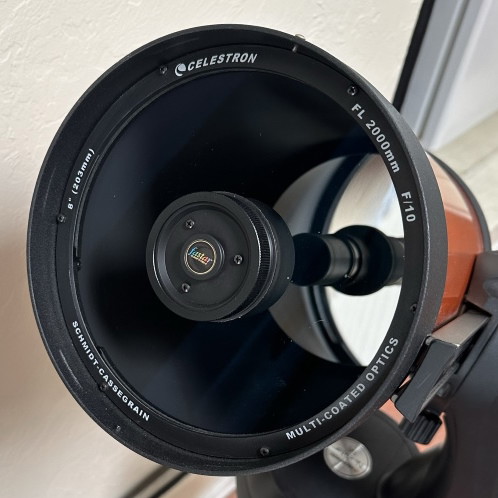
Since 1970, when the orange tube C8 made its debut, Celestron has been producing C8s in basically the same format. Despite revisions to the exact design of the tube, as well as the addition of Celestron’s StarBright XLT coatings and Hyperstar compatibility, the C8 is still essentially the same scope nearly forty years later.
From my own observations and optical testing, the Celestron NexStar 8SE is pretty good, optically.
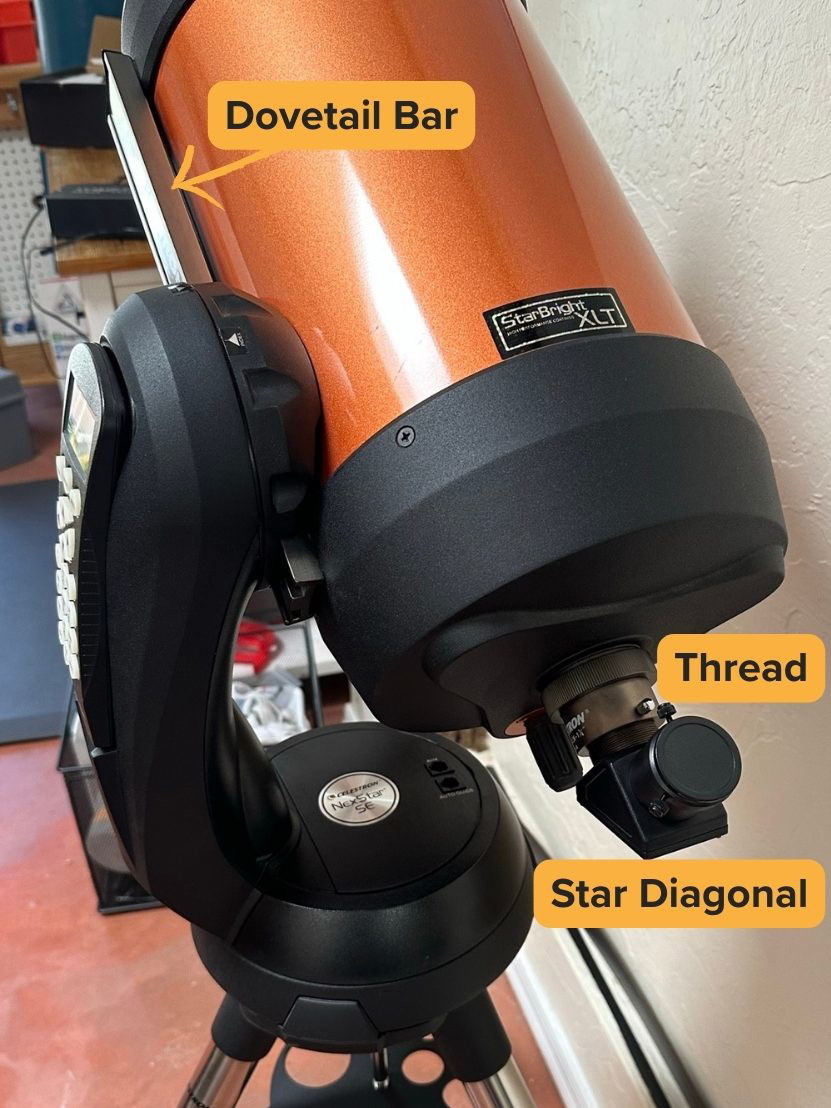
The Celestron NexStar 8SE has a long Vixen dovetail bar on the side of the optical tube, as seen in the image above. But I’m not really fascinated by it because the scope will only balance when the dovetail is all the way or almost all the way forward in the saddle. So I think it is mostly there for looks.
The 8SE’s moving-mirror focuser does cause some image shift (when focusing, the primary mirror wobbles, which causes the field of view to jiggle), but I don’t experience anything too severe.
The Collimation Difficulties
In the case of 8SE, collimation can be tedious as with any Schmidt-Cassegrain. For collimation, I must point the scope at a star (or an artificial equivalent), defocus it, and adjust the three small screws on the secondary mirror until everything is lined up.
I usually replace the screws with thumbscrews such as Bob’s Knobs to make things easier, but in this particular case, the introduction of thumbscrews was causing the scope to become miscollimated more often and was interfering with when attaching the lens cap. So I went back to the small screws the scope came with.
The Lone Eyepiece & Other Accessories
The Celestron NexStar 8SE computerized telescope comes with a single eyepiece—Celestron’s “E-Lux” 25mm Plossl—and a 1.25” star diagonal and 1.25″ visual back. I like that the included 1.25” diagonal is a prism of very high quality.
While the 25mm Plossl works well for low power, you will most likely need a 2″ star diagonal and wide-angle 2″ eyepiece for low power, as well as various 1.25″ eyepieces for higher magnifications. Eyepieces such as the gold-lines, Explore Scientific 68-degree and 82-degree, and Baader Hyperions are all great choices for the 8SE. I’d recommend something in the 6–8mm range for high magnification if you can only get one extra eyepiece.
If I’m using a 2″ screw-on (SCT) diagonal, I just have to unscrew the 1.25″ visual back and screw on a 2″ screw-on diagonal directly to the back of the 8SE optical tube. But if I only have a 2″ slide-in (refractor) diagonal on my hand, I need to first screw a 2″ visual back before adding the 2″ slide-in diagonal, which is less convenient. If you’re willing to spend money, a 2” screw-on diagonal and perhaps some 2” wide-angle eyepieces can be of some benefit.
The Celestron NexStar 8SE’s finderscope is a simple red dot finder, which is all I need to align the GoTo system. After alignment is complete, I don’t really need a finder at all.
The Unsteady Mount of NexStar 8SE
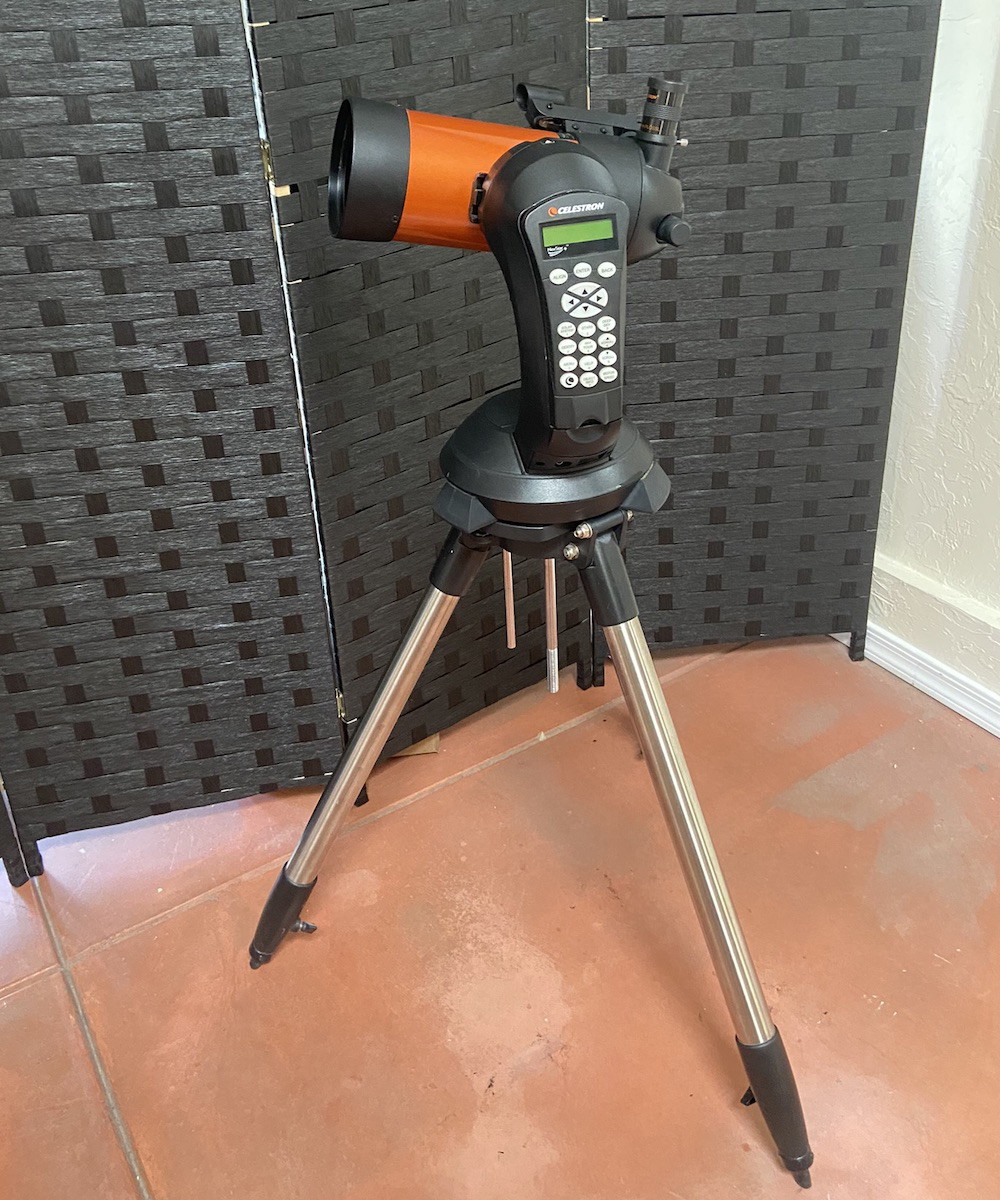
While the mount does work pretty well with the C8 optical tube assembly, the whole thing is not ideal to support the heavy optical tube and can be jiggly at high magnifications, particularly if I’m using any heavy accessories or have the legs extended fully. This also presents the problem that I could knock the scope out of alignment if I am not careful.
Celestron’s Vibration Suppression Pads, while mildly inconvenient to deal with, will alleviate some of the jiggles with this scope, but not completely.
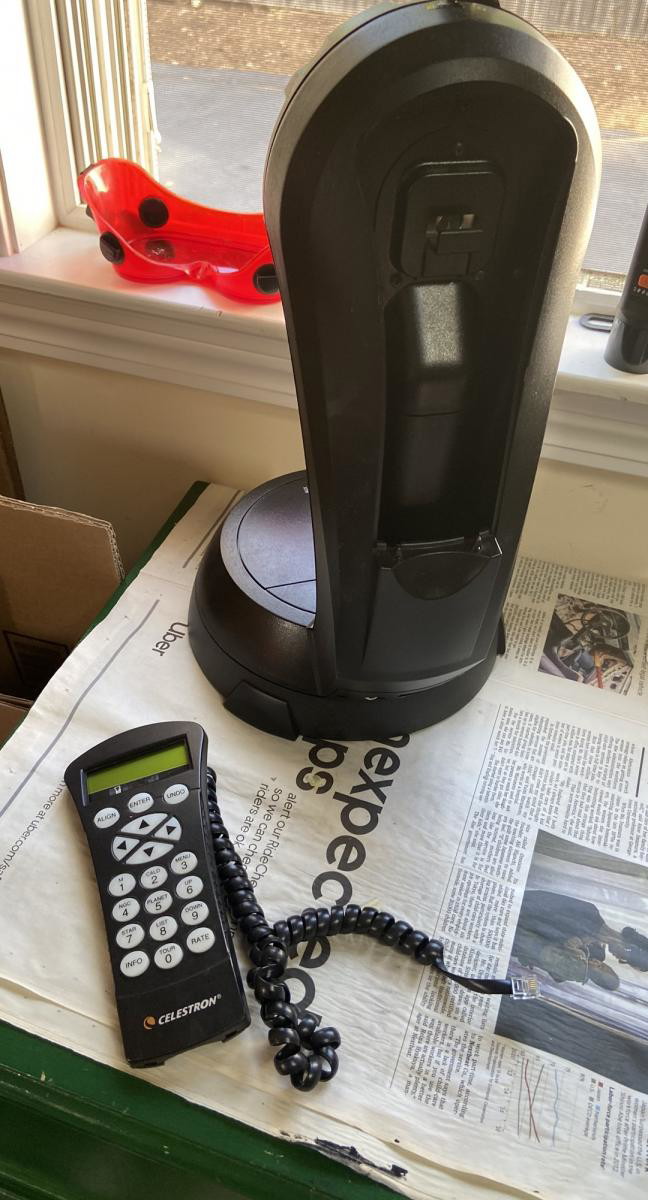
The 8SE mount takes eight AA batteries, but I recommend only using these as a backup. I use a portable 12-volt DC power supply and cord (Celestron even sells some meant specifically for astronomical use). But, I still always keep AA batteries in the scope’s battery compartment because if external power is lost accidentally and there is no internal backup, the scope will have to be rebooted and re-aligned.
The NexStar 8SE’s hand controller contains a catalog of about 40,000 objects. While the 8” aperture can show an impressive number of deep-sky objects and double stars, unfortunately, most of the 40,000 objects in the NexStar database are simply uninteresting, unaccompanied stars.
The 8SE mount has a Vixen saddle, so it can take other optical tubes in theory. However, only a Schmidt-Cassegrain or Maksutov-Cassegrain of the same size or smaller will be able to clear the base.
8SE and Its Astrophotography Capabilities
The Celestron NexStar 8SE is capable of very good lunar and planetary astrophotography with either a CCD camera or a DSLR. Both need a 2x or 3x Barlow lens for optimal sampling, and the latter requires a T-adapter. Just take a couple minutes of video and process it with the free programs Registax or AutoStakkert.
Simple deep-sky astrophotography of objects like the Orion Nebula and Andromeda Galaxy is possible with the NexStar 8SE, provided you obtain Celestron’s f/6.3 reducer and keep exposure times to under twenty or thirty seconds. Any longer than that and the alt-azimuth mount’s field rotation and small inaccuracies in the tracking will blur your images.
You could get a Starizona HyperStar and do longer exposures (along with a wider field and more detail with the same exposure length), but I believe an equatorially-mounted apochromatic refractor is probably a better choice for a beginner astrophotographer than the 8SE with HyperStar.
Should I buy a Used Celestron NexStar 8SE?
A used 8SE isn’t bad, and if you can get it at a low enough price (or as an optical tube only), it’s worth considering sticking it on a different mount such as a CG-5, Advanced VX, HEQ5, or Celestron’s beefier NexStar Evolution mount.
Alternative Recommendations
Personally, I’m hesitant to recommend the 8SE due to its less-than-steady mount, super-long focal length, and fairly high price for what you get. There are other scopes worth considering from Celestron and other manufacturers, with or without computers. Here are some of our top alternative picks:.
Under $1000
- The Apertura AD10/Zhumell Z10/Orion SkyLine 10 offers significantly more (56%) light-gathering ability and a slight uptick in resolution compared to the 8SE. More important, however, are the simplicity and stability of the provided Dobsonian mount and the included accessories, such as a 2” wide-angle eyepiece and laser collimator (along with the built-in 2” dual-speed Crayford focuser). The AD10/Z10 is rock solid and easy to aim, with an arguably similar form factor to the 8SE when stored or transported.
- The Apertura AD8/Zhumell Z8/Orion SkyLine 8 offers similar performance to the NexStar 8SE, but its shorter focal length and 2” dual-speed Crayford focuser allow for a much wider achievable field of view, and the Dobsonian mount is steadier, simpler, and easier to use—plus there’s the plethora of included accessories and the much lower price tag.
- The Sky-Watcher Virtuoso GTi 150P has less aperture than the NexStar 8SE, but its wide field and ultra-compact form factor might be just the ticket if you need a super-portable telescope. The collapsible tube and tabletop Dobsonian mount allow you to transport this scope in luggage or a large backpack. The GoTo mount is easily controlled via your smartphone or tablet (or just aimed manually!) and setup takes seconds. A manual version, the Heritage 150P, is also available at an even lower price tag, along with 130mm computerized and manual versions under the Virtuoso GTi and Heritage product lines respectively.
$1000-$1400
- The Apertura AD12/Zhumell Z12/Orion SkyLine 12 offers more than double (2.25x more, to be exact) the light gathering ability of the NexStar 8SE and 50% more resolving power. You get the same great features and accessories provided with the smaller AD/Z series deluxe Dobsonians, and with a large vehicle and/or a hand truck, transporting this scope is hardly any more difficult than the 8SE; if nothing else, it’s only two pieces to worry about. However, make sure you can handle this massive scope before committing yourself; it’s always possible to start smaller and upgrade to something like the AD12 or an even bigger Dobsonian later.
- The Celestron StarSense Explorer 10” Dobsonian offers some computerized capability thanks to the handy StarSense Explorer technology, as well as an easy-to-aim Dobsonian mount and fairly lightweight/portable design thanks to its weight-optimized base and built-in carry handles. Like the 8SE only a single eyepiece and red dot finder are provided, but upgrading later on (or preferably right away) is easy enough. An 8” model is also available, but the 10” scope is more capable, not much heavier, and doesn’t require tools to adjust the primary mirror for collimation like the 8” StarSense Explorer Dob does.
- The Celestron NexStar 6SE is steadier than the 8SE due to the lower weight of its optical tube on the single-armed fork mount, and the scope is a lot more compact, allowing for airline transport or fitting in a padded case or backpack. However, you do give up some performance from the 8SE due to the smaller 6” of aperture.
$1400-$2500
- The Celestron NexStar Evolution 8” is essentially (as the name implies) an evolved and vastly superior version of the NexStar 8SE. A pair of Plossl eyepieces are included as a standard so there’s no need to get anything else right away. The tripod is rock-solid, the mount arm is less jittery, you get a built-in lithium battery instead of having to worry about burning AAs or wiring up an external power supply, and you can connect to the telescope and control it with an app like SkySafari or use it with the provided hand controller. If you like the 8SE and want something without compromises, I would certainly recommend the Evolution 8” in its place. The Evolution 6” is also a great pick, though the advantages of it versus the steadier and more reasonably priced NexStar 6SE are less pronounced, especially for the money.
- The Sky-Watcher 8” or 10” FlexTube GoTo are significantly steadier than the 8SE and their shorter focal length allows for a wider possible field of view. Either model can also be aimed manually without upsetting the alignment of the GoTo system, and the Dobsonian mount is free of the obnoxious jitters of the undersized and wobbly 8SE mount and tripod.
- The Celestron Advanced VX 8” SCT is not quite as lightweight nor quick to set up as the 8SE or NexStar Evolution 8, but is rock steady and more suited for astrophotography. You can get fabulous results doing planetary imaging, and deep-sky imaging with an f/6.3 reducer or Starizona HyperStar is possible, or swap out the C8 optical tube for a small, fast refractor or reflector for less hassle or money spent.
Aftermarket Accessory Recommendations
The Celestron NexStar 8SE telescope can benefit from a number of accessory upgrades other than eyepieces.
More important than any of these, however, is arguably a dew shield.
On almost any night in most climates, it’s going to get damp enough that dew or frost can become a problem if you keep your 8SE outside long enough. A dew shield prevents moisture from condensing on the corrector plate by creating a boundary layer of air and has the additional benefit of shielding the innards of the telescope from some of the glare from the Moon, nearby street lights, or the general sky glow from light pollution. You can make a dew shield yourself or buy one from Celestron.
Lastly, a rechargeable power supply will allow you to ditch the AA batteries and save you a lot of money if you use your scope frequently, as well as avoid corrosion in the battery compartment. Rechargeable AA batteries are another option, but I like the rechargeable power supply because it’s harder to forget to charge it or run it down without noticing.
What All Can You See with the Celestron NexStar 8SE?
Once initial setup, alignment, and collimation are out of the way, the 8” aperture of the NexStar 8SE computerized telescope shows me a lot.
In the solar system, I can explore:
- Mercury and Venus’ phases
- The Moon’s ridges, faults, valleys, mountains, flatlands, craters, and more – any feature bigger than a mile is visible provided there are good atmospheric conditions and collimation.
- Mars’ albedo shading, ice cap, and dust storms
- Jupiter’s bands, cloud belts, Great Red Spot, and the moons as tiny colored disks
- Saturn’s rings and the division in them, its cloud belts, and a half dozen moons
- Uranus as a small turquoise disk, with possibly a moon or two.
- Neptune and its moon Triton
Outside the solar system, I can complete the entire Messier catalog, given half-decent skies, and even the Herschel 400 catalog with effort. Thousands of galaxies and star clusters, as well as hundreds of nebulae, are ours to explore, all readily accessible with the 8SE’s GoTo system.

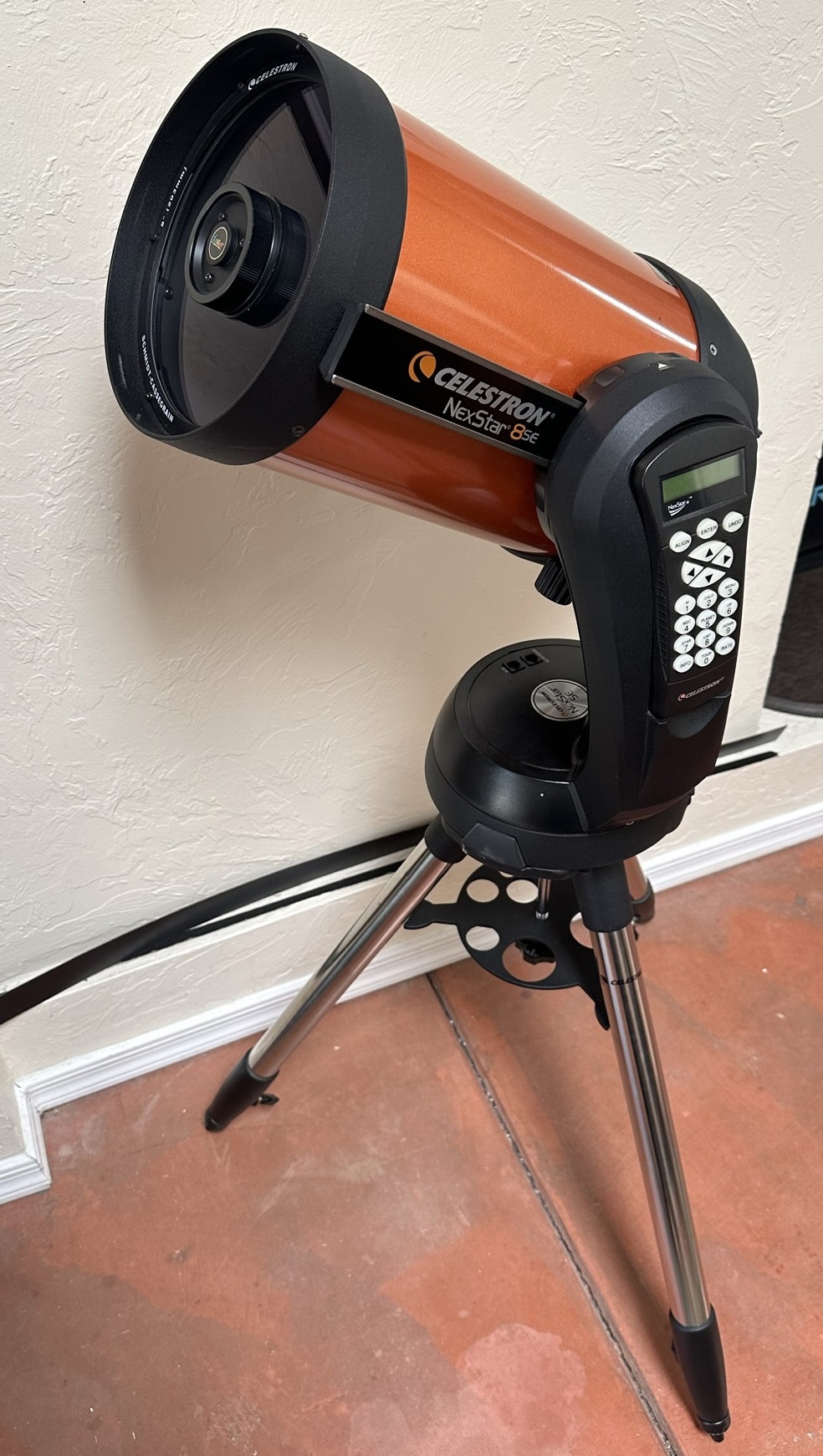


Hi!
I trust you.
I’ve just ordered one.
I’ve had an Orion Dobsonian 8” for a couple of years, but it has been too much struggle and too little fun. After having read so many positive reviews on the Celestron Nexstar 8SE, I finally placed an order on one for myself. I cannot wait. Thank you for sharing your experiences with us. Kind greetings from Denmark, Klaus
Lytzhøft
Hello Klaus,
How is it working for you? Would like to get a feedback!
As an owner of this specific mount for several years, I replaced the red dot finderscope with the telrad. Much better quality and always quick to align with the ota. While thus rig is pretty much a visual only rig, imaging the moon, planets,and the sun can produce some amazing results.
Which Telrad, specifically, did you get?
This one: https://www.amazon.com/Telrad-Finder-Sight/dp/B0000ALKAN/ref=sr_1_1?keywords=telrad&qid=1567194061&s=gateway&sr=8-1
Hi, i have this setup. The mount is power hungry, and i have the power tank. I would recommend a larger power supply. There is nothing worse than ending a wonderful viewing session because you lost power. This scope is light weight and very portable. However, i struggle with the tracking, and I am looking into a better tripod mount setup. Other than that, i would like a larger f.o.v.. the more that I use the scope the happier I am am. Rick
With the dew ring and “trash can” attached to the 8SE, I’ve found gravity likes to pull the scope downwards. Ive moved the scope as far back on the mounting rail as possible. Has anyone else experienced this issue? If so, have you found a way to keep the nose-up while observing objects near the horizon?
Add a heavier 2″ star diagonal, that will do it. Also try to slide the scope as far back in the saddle as you can without it possibly hitting the mount with the diagonal when aimed straight up.